As the primary freight haulage operators in the country the Railways have at one time or another owned and operated every conceivable form of road transport. They had large fleets of open wagons and vans for handling general merchandise and parcels and a range of heavy trailers for large or heavy items. Generally speaking the vehicles associated with higher value cargo such as parcels vans were painted in passenger livery, the remaining vehicles were usually painted in a plain single colour again usually based on passenger livery prior to the 1960's. BR lost most of its road delivery vehicles in 1969, following the closure of most of the goods yards, but operated a fleet of parcels vans until 1981 when that side of the business was wound up. Freightliners were operating their own fleet of lorries by the end of the 1960's and continue to do so today but other railway traffic relies on the customer or third party companies to supply any road transport that may be required.
Horse Drawn Vehicles
The railways used a wide range of two and four wheeled, one and two horse, delivery vehicles. Technically a cart has two wheels and a waggon has four (road waggons have two Gs in their name, railway wagons have only one).
There are one or two points that should be noted when modelling these vehicles, the two wheeled parcels vans were ballanced so the horse did not carry any weight. The example at the top of the sketch below is taken from a photograph of an LNWR example, note the angle of the body. When the driver and his mate mounted it would be almost level. The advertising poster on the side of the vehicle was a common feature of sundries and parcels vehicles from the early twentieth century to the 1960's. Usually a poster board was provided for this purpose, when not occupied these were a dark colour, possibly grey.
The rather Victorian looking covered waggon was still in use for railway deliveries into the mid 1930's (possibly surviving into the Second World War). This vehicle is about ten feet long and about ten feet high. The rear body is about five feet wide and is fitted with a set of hoops supporting a black tarred tarpaulin cover which had a hood at the front over the drivers seat. Note that the hooped supports and tarred canvass cover was not always used, some vans had light wooden panelled sides and a solid wooden roof.
The standard GWR pneumatic tyred horse drawn van was introduced in 1937 and the design was subsequently used by all four main railway companies (the Post Office adopted a slightly smaller version of the same basic design). Motor car wheels with pneumatic tyres were used and battery powered electric lights were fitted. A number of these vans survived into British Railways ownership and lasted in use into the late 1950's. A model of this van is available from Lledo in 'O' and Merit in OO scale and the design can be cribbed from the Peco catalogue for a scratch-build in N.
As 'common carriers (see Historical Background) the railways had to make provision for a wide range of unusual loads. The sketch at the bottom is taken from a photograph dated in the mid to late 1930's and shows a horse drawn trolley wagon with small (12-15 inch) diameter wheels. It has shafts for a single horse however a second horse could be attached in 'line ahead' if required. I am not sure what this was used for (possibly heavy loads) but it looks interesting and similar wagons could appear in any large goods yard. Modelling this wagon is described in the section on Wagon Loads & Materials Handling - Goods Yard Clutter.
Fig___ Typical horse drawn vehicles
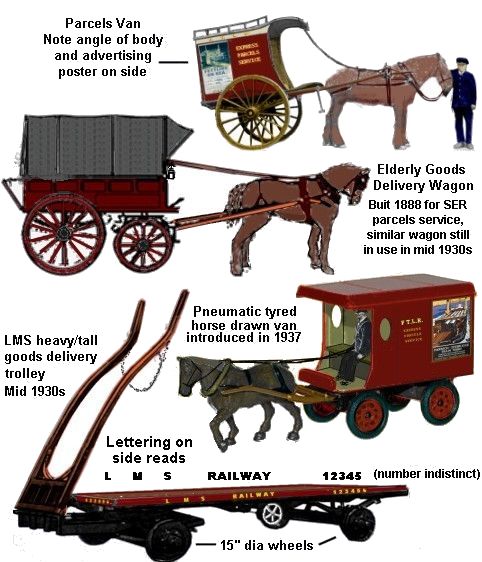
The bulk of the railway waggons in a goods yard would be flat-bed and low-sided trailer types for general merchandise, the less-than-wagonload side of the business was an important aspect of goods operations up to the 1960s. The railways, as common carriers, also produced more specialised equipment such as the horse drawn trolley fitted with a frame for plate glass shown below. Unless you have a glass works near by you would probably only see one or two of these in a yard at any one time.
Fig___ Horse drawn plate glass waggon
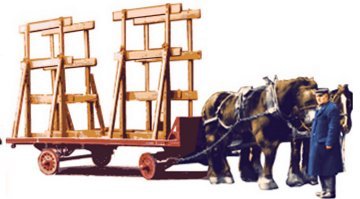
Horse drawn delivery vehicles, both railway owned and operated by other companies, were very much a feature of life in the railway goods yards. Generally they were equipped for either a single horse harnessed between two light wooden shafts or for a pair of horses, harnessed to either side of a single pole.
Horse drawn transport remained a feature of railway goods yards into the 1960's (British Railways 'inherited' a stock of over seven and a half thousand horses at Nationalisation). There were few thousand horse drawn delivery services still in operation by the 1940's and the last British Railways horse drawn vehicles were phased out in about 1959. The horse lasted as a shunter in the goods yards into the 1960's, the last two being retired at Newmarket yard in 1967.
The sketches below are all taken from photographs and show typical loading arrangements and driving positions.
Fig___ Typical horse drawn delivery vehicles
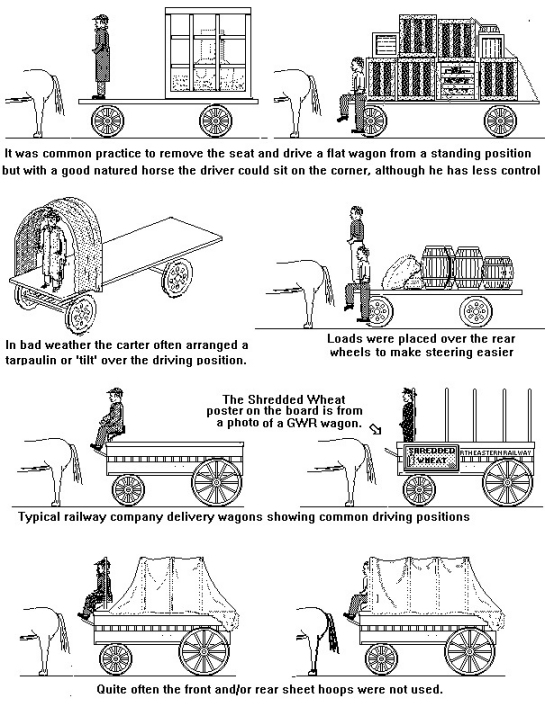
Most horse drawn delivery vehicles, at least in towns, were not brightly coloured. Talking to old folks a recurring comparison was that they 'were not like ice cream vans'. Black and brown seem to have been the preferred colours, some wagons had the spokes on the wheels painted red, lettering was mainly yellow or white. The railway companies used similarly subdued colours, the SR used green changing from solid yellow lettering to outlined white in the 1930's, the LMS used maroon with yellow lettering, the LNER blue with (I think) white lettering and the GWR brown (with cream upper parts on hard bodied parcels vans) and yellow lettering. The Big four liveries were still occasionally seen into the mid 1950's, especially at outlying stations. BR used crimson and cream followed by maroon, changing to yellow in the 1960's. The maroon does not seem (from the photographs I have seen) to have been widely applied. There was I believe an all-over 'sand' livery used just before the change to yellow but I cannot confirm the dates or the exact colour used.
Three wheel petrol vehicles
The three wheeled motor vehicle offers a number of useful advantages, it is cheaper to build, easier to maintain and (depending on the position of the single wheel) it can have a very small turning radius. The most stable arrangement has the axle with two wheels on it at the front, most three wheeler motor cars have this layout. There are two snags with this arrangement for a cargo vehicle, firstly the load is best carried above the axle, so the driver of a goods vehicle with this wheel arrangement ends up at the rear, looking over the load. Secondly the driven rear wheel cannot be used for steering so the vehicle relies on Ackerman type steering on the front wheels, giving it a turning radius similar to that of a four wheeler. There were some delivery vehicles that used this arrangement however, one example being the Autocarrier shown below (Autocarrier are perhaps better known as the makers of AC cars). This small machine was in production between 1904 and 1914 and had what was in effect the rear end of a motorbike with the load carried in a box between the front wheels. Several of these were sold to the railway companies for use as parcels delivery machines (the GWR had three but I am not sure where they were based).
Fig___ Autocarrier three wheeler

In the busy town goods yards there was usually a large number of railway owned and private horse drawn wagons being loaded or unloaded and there might also be some railway company Karrier Cob 'mechanical horses'. The Karrier Cob, introduced in 1930, was a very small three wheeled petrol vehicle developed in response to railway company requirements and intended as a simple replacement for a horse. These are described in the section on Railway Company Goods Facilities - Goods Yards and Wharfs. Later versions were provided with a purpose built trailer unit. A white metal kit of the Karrier Cob is now available from Langley in OO, these vehicles are rather small to model in N but it can be done.
The success of this simple machine prompted the development of a number of larger three wheeled tractor units which could pull a useful load through narrow streets and within the confines of a factory. As they were originally seen as a replacement for a horse the name 'mechanical horses' remained in general use despite the best efforts of the manufacturers. The little three wheeled tractor and its articulated trailer was developed into a thoroughly modern road vehicle, retaining the very tight turning circle as a virtue of the single front wheel. The most successful series, produced by Scammel, continued in development and production up to the mid 1960's. A white metal model of the 1935 Scammel type may now be available as a kit from Lytchett Manor Models (link on the links page - This company now own the former Fleetline and Skytrex molds), this may come with a flat bed trailer.
Fig___ Three wheeler delivery lorries
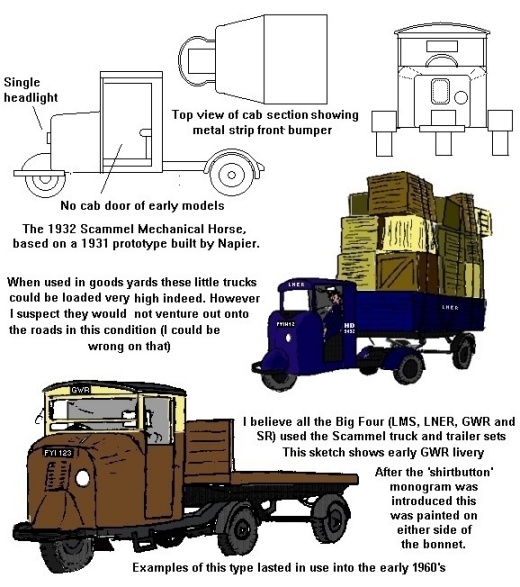
A 1950's version, with a slightly more bulbous nose and a covered trailer (standard BR issue) is available from Langley and from Graham Avis. With a bit of carving at the front these can be converted to something resembling the early designs of the 1920's. The Scammel Scarab was built in three ton and six ton versions and they were a common sight in the early British Railways era. They were not terribly fast but they had a good turning circle and proved very successful for local delivery work.
Fig___ Preserved Scammel 'Scarab' 6 ton lorry in original BR livery

The flashing indicators on the roof were added in the early 1970's due to changes in the law.
Fig___ Preserved Scammel 'Scarab' lorry in original (but slightly different) BR livery
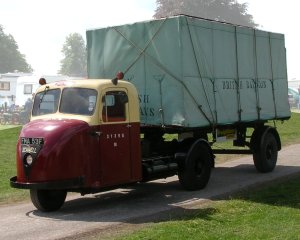
I believe the final version of the Scammel mechanical horse used by the railways was the Townsman, a fiberglass bodied three wheeler introduced in 1966. The sketch shown below is based on a photograph of a preserved example, I am not sure the arrow logo on the door is facing the right way, as this was not an official 'crest' I believe the black arrows pointed to the left on both sides. The photograph was posted by Barry Ruck on the newsgroup alt.binaries.images.vintage-engineering. I would advise keeping an eye on this news group, I have found several ideas for wagon loads and odd bits of equipment for factories and fields. If you are in the habit of visiting vintage rallies a few photographs uploaded would not go amiss, the group is largely kept going by Barry at the moment.
Regarding these early articulated vehicles Tim Cotter was able to advise
Re the Scammel Townsman. This was replaced in 1970 by the Ford D series "baby" artic with the Hands trailer and Scammel automatic trailer coupling. (Not the fifth wheel type) The tractor was a D-300 with the 240 four cylinder Ford engine and 16 inch wheels. (My bus stop to school was opposite a BR vehicle garage in Plymouth and my uncle had a D-300 truck.)
Bedford and Karrier also did a similar and compatible artic tractor but I'm not sure they were used by the railway companies.
Other railway owned motor vehicles
From the 1920s the railway companies made increasing use of motor vehicles for delivering and collecting goods, the lorry below left is a typical 1920s example. A lot of goods were hauled on trailers, where the item was too heavy for the three wheelers discussed above a dedicated 'tug' was used. The railway companies operated a number of steam tractors for this work but by the 1930s agricultural tractors were being converted for use as tugs. The example shown below dates from the 1930s, it has road-going pneumatic tyres and has a cab fitted.
Fig ___ An early lorry and a converted agricultural tractor

The LNER (and presumably other railway companies) operated similar tractors, one job being to tow the road-rail tank trailers used for milk traffic from the station to the factory. Examples were still in use into the early 1950s.
Conventional four wheeled lorries became commonplace in the later 1930s and the railways operated the largest fleets of lorries in the country. The example below dates from 1944, the livery shown is early BR crimson and cream.
Fig___ 1944 Bedford lorry in early BR livery
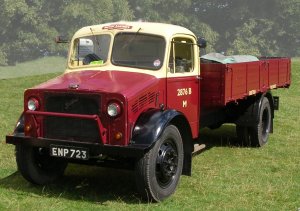
For larger items of general goods or longer haul deliveries the railways maintained a varied fleet of lorries and vans. To handle the road-rail trailer loads, such as wheeled road tanks or special heavy lift trailers, the railways operated a fleet of 'tugs'. These were conventional lorries, usually on a fairly short wheelbase chassis, and fitted with 'ballast boxes' to increase their grip. These vehicles replaced steam traction engines and were normally seen in railway company livery, green for the SR, maroon for the LMS, chocolate and cream for the GWR and blue for the LNER followed by crimson and cream in the early BR era. The tugs were quite a common sight in the 1950's, less so in the 1960's and I do not recall seeing any (other than top-and-tailing very big low-loaders) in the 1970's. In the mid 1960's BR changed to using an all-over yellow livery for general goods vehicles with lettering in black and the boxed arrow 'door to door' marking in red and black. This logo was apparently applied to everything connected with goods traffic, including the cranes used in goods yards, I believe they changed to using the standard BR double arrow logo in the early 1970's. For service vehicles such as the yellow mess vans I believe the standard BR arrow logo was used and if memory serves this was in black.
Fig___ British Railways Lorries & Vans
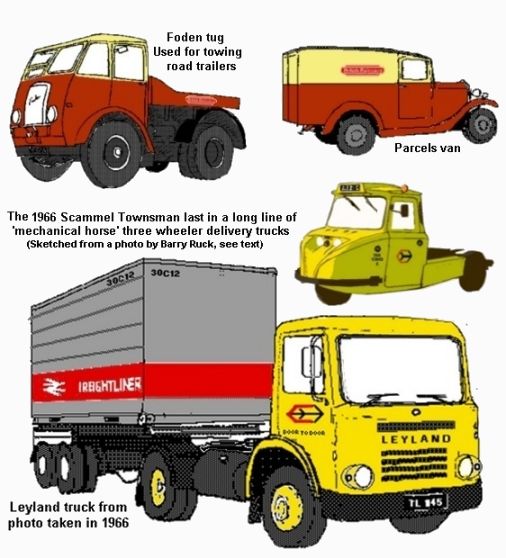
All these vehicles were transferred to National Freight Carriers in 1969 but some were then leased back to British Railways for the remaining wagon load delivery work and parcels collection and delivery services. Motor vans were used for railway parcels collection and delivery work and contemporary designs of van were seen in British Rail Parcels livery until the that service was closed down in 1981.
The sketch below shows what I believe to be the 'Corporate era' liveries, I could be wrong on these as they are based on black and white photographs and I have used a generic van as the basis of the sketches.
Fig___ BR road vehicles in later liveries
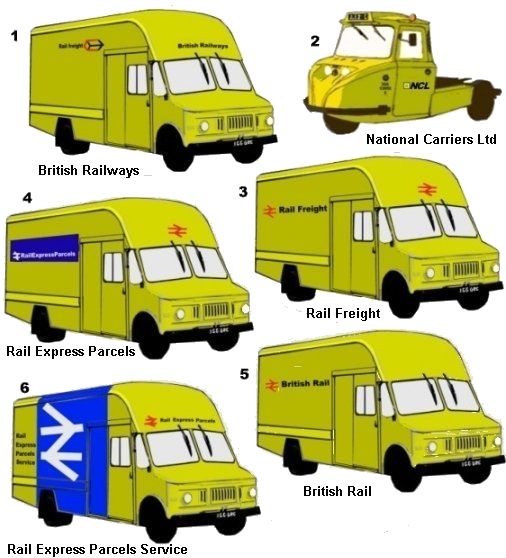
1. Although BR favoured tractor-trailer combinations (typically buying two or three trailer units for each tractor) they did operate a substantial fleet of rigid lorries and vans. This shows what I believe was the early 'door to door' livery on a walk-thru van. The lettering says Rail freight (only the R is capitalised)
2. This is a Scammel showing the National Freight Carriers livery (they traded the former BR sundries fleet as National Carriers Ltd hence the NCL on the door).
3. Shows the early double arrow era livery for a general freight or sundries delivery van.
4. Shows the separate Express Parcels livery (the white writing on the side reads Rail Express Parcels).
5. Shows the livery used for vehicles being used by BR for the engineers, signal and telegraph people etc.
6. Shows the final express parcels livery, the lettering at the rear of the side reads Rail Express Parcels Service, the lettering on the front says Rail Express Parcels.
This period is not an era I have much interest in modelling so I may have some errors in these pictures. Any comments would be welcome.
Note - Ken Ward, a regular on uk.railways newsgroup advised that the official colours for British Road Services, the nationalised road haulage company, were: General Haulage - Red, Vans - Green, Meat - Cream, Special Traffic (eg tipper lorries) - Blue. In 1969 introduced regional colours on its general goods vehicles as follows: South Eastern Division - ROYAL BLUE, Scottish Division - TRAFFIC BLUE, North Western Division - SEA GREEN, North Eastern Division - ROAD HAULAGE RED, Midland Division - NUT BROWN, South Western Division - ROAD HAULAGE GREEN, Western Division - LEAD GREY, Eastern Division - TURQUOISE BLUE. Parcels vans operated by BRS remained green.
National Freight Carriers, who marked their vehicles National Carriers Limited or NCL, was formed in 1968, basically transferring the railways loss-making less than wagon load traffic to a company that could use road or rail transport. The NFC worked in collaboration with the railways, a lot of the delivery work of BR parcels traffic was carried out using NFC vehicles until the railways withdrew from parcels traffic in 1981. The privatisation of many of the UK's publicly owned Businesses began with the National Freight Corporation (NFC) Management Employee buy-out in 1982. The NFC then formed the basis of Excel, which came into being in 2000 out of the merger of Ocean Group and National Freight Corporation, the new company then snapped up Tibbet & Britten in 2004, becoming one of the largest and most successful logistics companies in the UK. In 2006 Deutsche Post completed a £3.7 billion takeover of the freight company and merged it with its own DHL Logistics, the joint company now operates in 135 countries.